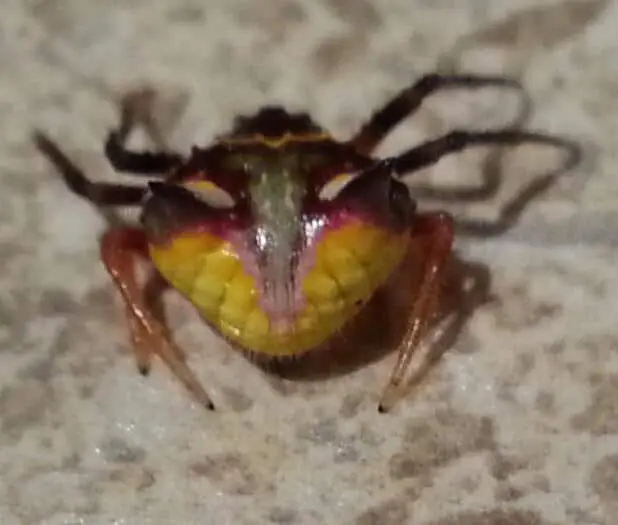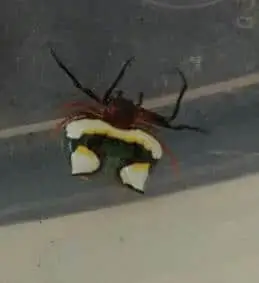The Two Spined spider (Poecilopachys Australasia) is a nocturnal spider. It is an immigrant to Australia and has been recorded in New Zealand since the early 1970s.
Table of Contents
Description:
The female, Poecilopachys Australasia is about 8 mm in length and when mature has two white horn-like spines. Yellow and white bands and some red-brown markings are visible. Large body hairs on an adult female gradually disappear as she approaches maturity.
The male is much smaller (2.5 mm – 3 mm in length) and looks very different. . Adult males lack the pair of large abdominal spurs and the bright colours that characterize the adult females. They look so different that they were first thought to be a different species.

Despite their conspicuous colours, they are seldom seen as they usually hide under leaves during the day. At night they emerge and spin a horizontal orb web to catch night-flying insects such as moths. In the morning they eat their web completely and settle down to hide for the day. The Two Spined Spider is one of the few spiders that can change colour quickly, perhaps to confuse potential predators.
Habitat:
The Two Spined spider is found in gardens on shrubs, often on citrus trees. By day, the spider will hide under leaves, emerging at night to construct a cart wheel-shaped web.
Prey:
Despite the small size of the Two Spined spider, it is capable of capturing moths and other insects several times its own size.

Web:
This species only forms a small orb web at night and is not often noticed during the daylight hours as it rests underneath green leaves. It makes a small orb web during the night and may also be found guarding a small brown spindle-shaped, papery egg sac.
Breeding: The egg sac of the two spined spider is spindle shaped.
Venom:
Two Spined spiders are regarded as harmless to humans. The toxicity of the venom of this spider towards humans is unknown but it is a small, non-aggressive spider and thus is most unlikely to cause significant harm.
Bibliography:
Find a Spider Guide
Australian Museum website
Information and pictures were taken from children’s projects and where credited to that child does not claim to be original information. Where possible, permission to reproduce has been sought. Any infringement of copyright is purely unintentional.
